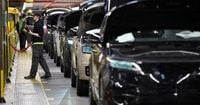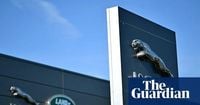Jaguar Land Rover (JLR), the luxury vehicle arm of India’s Tata Motors and Britain’s largest native automaker, has begun the arduous process of restarting production after a crippling cyberattack brought its factories to a halt for nearly a month. The incident, which unfolded in early September 2025, left the company’s three UK manufacturing facilities silent, threatened the livelihoods of more than 33,000 employees, and sent shockwaves through a supply chain that supports an estimated 120,000 additional jobs across Britain.
According to Reuters, the company confirmed on September 29 that “some manufacturing operations will resume in the coming days,” marking the first tangible step toward recovery. This phased restart, JLR emphasized, would be controlled and deliberate—a necessity, given the scale of the disruption and the fragility of digital systems still under scrutiny by cybersecurity experts.
The crisis began when hackers—believed by experts to have deployed a sophisticated ransomware or destructive intrusion—penetrated JLR’s digital infrastructure. The attack disabled systems that orchestrate logistics, inventory, and assembly lines, effectively paralyzing production. As Road & Track reported, the company’s ability to pay suppliers, process vehicle wholesales, and keep parts flowing to retailers was severely compromised. The result? Losses estimated at a staggering £50 million (US$68 million) per week, with economist David Bailey warning in the Financial Times that total revenue losses could ultimately exceed $4.7 billion.
“We know there is much more to do, but the foundational work of our recovery is firmly underway, and we will continue to provide updates as we progress,” JLR said in a statement cited by Industrial Equipment News. The company acknowledged that, while it had restored some digital assets—including IT processing for invoicing and the financial system for wholesales—it would take significant time to fully clear backlogs and return to normal operations. The Global Parts Logistics Center, which supplies components to dealers worldwide, was also returning to full operation, providing much-needed relief for both retailers and customers experiencing delays and cancellations.
The Wolverhampton engine plant in the West Midlands, a linchpin in JLR’s powertrain production, is expected to be among the first facilities to resume manufacturing. Industry analysts told Auto Connected Car News that JLR’s measured approach reflects the complexity of modern automotive supply chains, where even brief disruptions can cascade across a vast network of domestic and international partners—many operating on razor-thin margins.
The severity of the attack has brought renewed scrutiny to the resilience of Britain’s manufacturing sector. As BBC and Reuters noted, JLR joins a growing list of major UK organizations—including Marks & Spencer and the Co-op Group—targeted by increasingly sophisticated cybercriminals. Cybersecurity expert Eric O’Neill, a former FBI agent, told Industrial Equipment News that “these attacks share a dangerous pattern: the breach came despite heavy investment in cybersecurity. Resilience is what matters—before the attack.” O’Neill outlined a three-step recovery process for JLR: containment and eradication of the attackers, forensic investigation and restoration from clean backups, and, finally, building resilience to prevent future breaches.
“JLR is almost certainly following the standard high-stakes incident response playbook that critical manufacturers use when ransomware or destructive attacks hit,” O’Neill explained. He warned that the company must do more than simply expel the intruders; it must also prove that its systems are clean and bolster its defenses against future threats. Cybersecurity experts estimate it could take up to a year for JLR to be fully operational, underscoring the long shadow such attacks cast over even the most advanced manufacturers.
The financial fallout from the shutdown has been severe. JLR’s quarterly sales dropped 11% in July 2025, a decline exacerbated by temporary pauses in US exports after the Trump administration imposed tariffs on all car imports. Although shipments to the US resumed in May, the company slashed its fiscal 2026 profit margin target to 5%-7%, down from 10%, citing continued uncertainty around US trade policies and the enduring effects of the cyberattack.
To stabilize the company and its vast ecosystem of suppliers, the UK government stepped in with a £1.5 billion (about US$2 billion) loan guarantee on September 26, 2025. As reported by Bloomberg and Road & Track, the package is designed not only to shore up JLR’s finances but also to prevent insolvency among smaller suppliers whose survival depends on the automaker’s consistent demand. “The move will help support the supply chain and protect skilled jobs,” British business secretary Peter Kyle stated, according to Road & Track. The government’s intervention reflects JLR’s strategic importance to Britain’s industrial landscape, where its suppliers underpin much of the nation’s automotive sector.
Even with government backing, JLR sought to raise an additional £2 billion (approximately US$2.7 billion) from private banks, as reported by Automotive News and Financial Times. The company’s credit rating was affirmed at Ba1 by Moody’s, but the outlook was revised from positive to negative. “The outlook change to negative from positive reflects our view that a full recovery in credit metrics will likely take several months,” Sweta Patodia, Assistant Vice President and Analyst at Moody’s, told Reuters.
The cyberattack also exposed JLR’s lack of cyber insurance at the time of the breach, an omission that could have offset some of the financial pain. The incident is expected to accelerate investment in cybersecurity across the automotive sector, especially as vehicles become increasingly software-driven and reliant on interconnected systems. JLR, already engaged in a transition toward electrification and advanced driver-assistance technologies, is now expected to make cybersecurity a central pillar of its digital strategy.
Meanwhile, Tata Motors is preparing for a major restructuring. Starting October 1, 2025, the company will split into two independent entities: one focused on passenger vehicles and the other on commercial vehicles. Shailesh Chandra will become managing director and CEO of Tata Motors, retaining his role at Tata Passenger Electric Mobility, while Girish Wagh will lead the new commercial vehicle business. The move, according to Mexico Business News, is intended to give each unit greater autonomy and agility in a rapidly evolving market.
For JLR’s workforce and the communities that depend on its success, the restart of production offers a glimmer of hope after weeks of anxiety. Unions have urged the company and government to ensure robust protections are in place to prevent similar crises in the future. As JLR works around the clock to resume operations and restore confidence, the lessons from this ordeal are likely to resonate far beyond its factory gates, shaping how the entire automotive industry approaches digital security in an era of relentless technological change.
JLR’s journey back to full strength will be long and fraught with challenges, but the company’s response—and the support it has received—underscore its enduring significance to Britain’s economy and the global automotive landscape.


